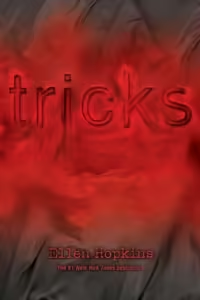Tricks
Ellen Hopkins
Margaret K. McElderry Books
Published August 25, 2009
Amazon | Bookshop | Goodreads
About Tricks
Five teenagers from different parts of the country. Three girls. Two guys. Four straight. One gay. Some rich. Some poor. Some from great families. Some with no one at all. All living their lives as best they can, but all searching … for freedom, safety, community, family, love. What they don’t expect, though, is all that can happen when those powerful little words “I love you” are said for all the wrong reasons.
Five moving stories remain separate at first, then interweave to tell a larger, powerful story—a story about making choices, taking leaps of faith, falling down, and growing up. A story about kids figuring out what sex and love are all about, at all costs, while asking themselves, “Can I ever feel okay about myself?”
My Review
I think it’s interesting that the cover copy of the book only mentions one of the queer characters. There are two point-of-view characters who are queer: Seth, who’s gay, and Ginger, who’s a lesbian. I wish the cover copy included mention of her.
This is a pretty dark book, but that’s kind of Ellen Hopkins’s brand. Tricks is the fourth book of hers that I’ve read, but it’s the first one I’ve read in a long time. Her books offer unflinching tales of teens enduring the kinds of hardships we are tempted to reduce to statistics.
Including five perspectives in a single novel in verse makes this a pretty ambitious project. We meet five different teens with five different back stories from five different parts of the country, so that’s a lot to track as we shuffle from one point of view to another. Some of the characters come from homes that seem stable and even loving. Others have already experienced deeply scarring trauma. Some of the character descriptions felt so abbreviated as to almost make them stereotypes. At least part of that may be because of the number of point-of-view characters in the book and the spare format of verse storytelling.
I think the book is also a product of its day, too. Since 2009, we’ve had a lot more conversations about the harmful effect of slut-shaming or perpetuating the stigma of prostitution. As I read, I found myself wondering how those more recent conversations might impact the words characters use.
The story doesn’t romanticize human trafficking. If anything, it’s a cautionary tale showing how, under the wrong circumstances, anyone can become a victim of trafficking. The author’s note in the backmatter encourages readers who need help to call a hotline specifically for teens in danger.
Tricks is One of the Most Frequently Challenged Books of 2023
Tricks was one of the top ten most challenged books of 2023. Among the reasons I saw cited for the challenges and book bans were that it contains queer characters, references to rape, and sexually explicit content.
Tricks does contain some explicit content. The graphic scenes are short and point up the danger characters face, the powerful emotions at play, or the way their relationships are evolving. This isn’t a book that will appeal to or be appropriate for every reader, but it’s a story and message that will resonate with some.
Content Notes for Tricks
Content warning for drug use, sexual assault, child abuse, and brief gun violence.
Recommended for Ages 16 up.
Representation
Two characters are queer.
Profanity/Crude Language Content
Some use of the F-bomb and other profanity.
Romance/Sexual Content
Slut-shaming language used. References to sex and sex work. References to sexual assault and scenes briefly showing the assault. Kissing between two boys, two girls, or a boy and girl. A couple of scenes reference sex between more than two people.
Spiritual Content
References to Christian services and faith practices. References to faith used to control others’ behavior and abuse them.
Violent Content
References to and brief descriptions of sexual assault. References to a child hit by a car. A parent physically abuses their child and then drugs them. More than one character is in the power of an abusive romantic partner. One character is locked in a room with no food for days and kept in abusive conditions for longer. In one scene, a person with a gun shoots several others.
Drug Content
Teens drink alcohol and use marijuana and hard drugs. One character also becomes addicted to gambling.
Note: This post contains affiliate links, which do not cost you anything to use but help support this blog. All opinions are my own.
